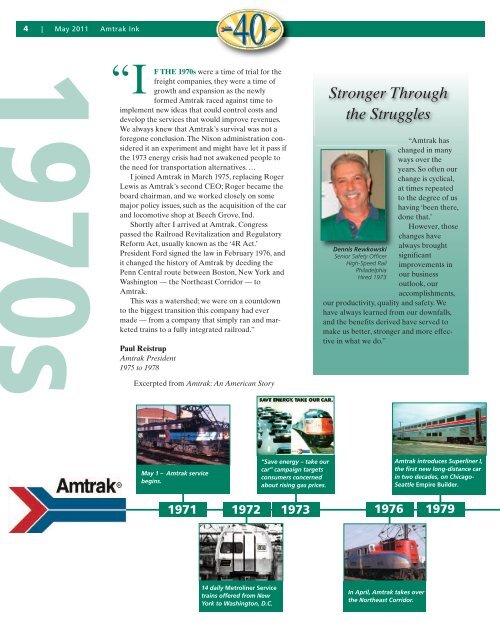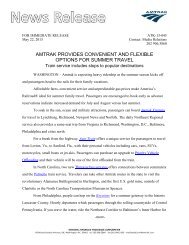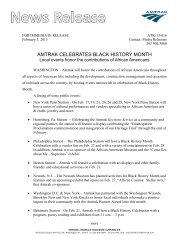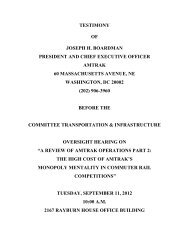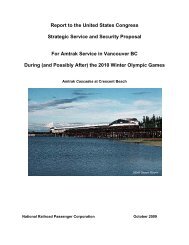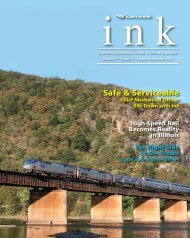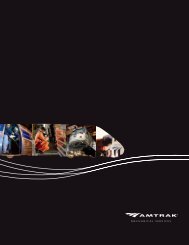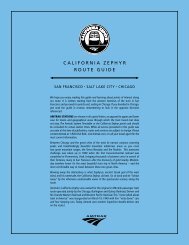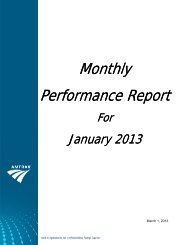May 2011 - Amtrak
May 2011 - Amtrak
May 2011 - Amtrak
Create successful ePaper yourself
Turn your PDF publications into a flip-book with our unique Google optimized e-Paper software.
4 | <strong>May</strong> <strong>2011</strong> <strong>Amtrak</strong> Ink<br />
“I<br />
F THE 1970s were a time of trial for the<br />
freight companies, they were a time of<br />
growth and expansion as the newly<br />
formed <strong>Amtrak</strong> raced against time to<br />
implement new ideas that could control costs and<br />
develop the services that would improve revenues.<br />
We always knew that <strong>Amtrak</strong>’s survival was not a<br />
foregone conclusion. The Nixon administration considered<br />
it an experiment and might have let it pass if<br />
the 1973 energy crisis had not awakened people to<br />
the need for transportation alternatives. …<br />
I joined <strong>Amtrak</strong> in March 1975, replacing Roger<br />
Lewis as <strong>Amtrak</strong>’s second CEO; Roger became the<br />
board chairman, and we worked closely on some<br />
major policy issues, such as the acquisition of the car<br />
and locomotive shop at Beech Grove, Ind.<br />
Shortly after I arrived at <strong>Amtrak</strong>, Congress<br />
passed the Railroad Revitalization and Regulatory<br />
Reform Act, usually known as the ‘4R Act.’<br />
President Ford signed the law in February 1976, and<br />
it changed the history of <strong>Amtrak</strong> by deeding the<br />
Penn Central route between Boston, New York and<br />
Washington — the Northeast Corridor — to<br />
<strong>Amtrak</strong>.<br />
This was a watershed; we were on a countdown<br />
to the biggest transition this company had ever<br />
made — from a company that simply ran and marketed<br />
trains to a fully integrated railroad.”<br />
Paul Reistrup<br />
<strong>Amtrak</strong> President<br />
1975 to 1978<br />
Excerpted from <strong>Amtrak</strong>: An American Story<br />
<strong>May</strong> 1 – <strong>Amtrak</strong> service<br />
begins.<br />
1971<br />
1972<br />
14 daily Metroliner Service<br />
trains offered from New<br />
York to Washington, D.C.<br />
“Save energy – take our<br />
car” campaign targets<br />
consumers concerned<br />
about rising gas prices.<br />
1973<br />
Stronger Through<br />
the Struggles<br />
Dennis Rewkowski<br />
Senior Safety Officer<br />
High-Speed Rail<br />
Philadelphia<br />
Hired 1973<br />
1976<br />
In April, <strong>Amtrak</strong> takes over<br />
the Northeast Corridor.<br />
“<strong>Amtrak</strong> has<br />
changed in many<br />
ways over the<br />
years. So often our<br />
change is cyclical,<br />
at times repeated<br />
to the degree of us<br />
having ‘been there,<br />
done that.’<br />
However, those<br />
changes have<br />
always brought<br />
significant<br />
improvements in<br />
our business<br />
outlook, our<br />
accomplishments,<br />
our productivity, quality and safety. We<br />
have always learned from our downfalls,<br />
and the benefits derived have served to<br />
make us better, stronger and more effective<br />
in what we do.”<br />
<strong>Amtrak</strong> introduces Superliner I,<br />
the first new long-distance car<br />
in two decades, on Chicago-<br />
Seattle Empire Builder.<br />
1979


